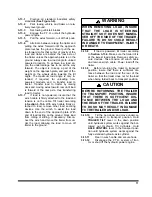
3-13.1
Practice all standard industrial safety
standards
(See Figure 3-4).
3-13.2
Park towing vehicle and trailer on rela-
tively level ground.
3-13.3
Set towing vehicle’s brakes.
3-13.4
Engage the P.T.O. or start the hydraulic
power engine.
3-13.5
Pull the axles forward, out of their pock-
ets.
3-13.6
Alternate between raising the trailer and
pulling the axles forward until the approach
plate touches the ground. Never pull the ax-
les forward so far that center of gravity of the
load and trailer are behind the rear axle of
the trailer unless the approach plate is on the
ground. Always use low load angle to unload
powered products. To achieve low load an-
gle, the undercarriage has to be all the way
forward. The object is to keep a part of the
weight on the approach plate, and part of the
weight on the wheels while lowering the tilt
angle. The maximum load angle is only in-
tended, if required, for unloading non-
powered products and to transfer load to
tractor. Transfer load to tractor by raising
deck and moving axles toward rear until load
is forward of the rear axle, thus transferring
load to tractor.
3-13.7
If load is non-powered, insure that the
winch cable is firmly attached to the load and
tension is on the cable. Tilt trailer according
to
Section 3-13.6.
With winch cable firmly at-
tached to load, remove other load securing
devices. Use the winch to assist the load
down to the end of the approach plate. With
end of load resting on the ground, block load
from rolling or sliding, if necessary. Discon-
nect the winch and move the trailer from un-
der the load, allowing the load to move off
trailer to the ground.
WARNING
WHEN REMOVING LOAD, INSURE
THAT THE LOAD IS STEERING
STRAIGHT SO IT DOES NOT MANEU-
VER OFF THE SIDE OF THE TRAILER.
FAILURE TO DO SO COULD RESULT
IN DAMAGE TO EQUIPMENT, INJURY,
OR DEATH.
3-13.8
If load is powered, tilt trailer according
to
Section 3-13.6.
Make sure the trailer tilt is
at the lowest load angle. Remove safety se-
cure devices. Take tension off winch cable
and remove winch cable. Power load off the
trailer.
3-13.9
Before returning the trailer to transport
position, insure that there is sufficient dis-
tance between the load and the rear of the
trailer so that the trailer does not hit the load
when being folded back to transport position.
CAUTION
BEFORE RETURNING THE TRAILER
TO TRANSPORT POSITION, INSURE
THAT THERE IS SUFFICIENT DIS-
TANCE BETWEEN THE LOAD AND
THE REAR OF THE TRAILER. FAILURE
TO DO SO MAY RESULT IN DAMAGE
T0 THE TRAILER AND/OR LOAD.
3-13.10
Tilt the bed down and move undercar-
riage rearward to transport position. Hold
TRAILER TILT
lever in the down position
until hydraulic system works against the bot-
tomed out Hydraulic Tilt Cylinders. Hold
AXLE CONTROL
lever in the transport posi-
tion until hydraulic system works against the
fully extended hydraulic axle cylinder.
3-13.11
Reel in winch cable and secure hook.
3-13.12
Disengage the P.T.O. system of trac-
tor or shut off the hydraulic power engine.
11
Содержание 345B
Страница 3: ...MODEL 345B TRAILER OPERATOR S MANUAL PURCHASED FROM DATE ADDRESS PHONE NO SERIAL NO ...
Страница 8: ......
Страница 12: ......
Страница 22: ...3 10 Figure 3 4 Steps for Loading and Unloading ...
Страница 26: ...3 14 Figure 3 7 Rear Impact Guard and Antilock Brake System ...
Страница 30: ......
Страница 35: ...4 5 Figure 4 2 345B Wiring Diagram ...
Страница 36: ...4 6 Figure 4 3 Remote Wiring Diagram ...
Страница 41: ...4 11 Figure 4 5 Examples of Camber Figure 4 6 Checking Axle for Bend ...
Страница 46: ...4 16 Figure 4 10 Axle and Brake Assembly ...
Страница 50: ...4 20 Figure 4 13 Outboard Mount Hub and Drum Figure 4 14 Inboard Mount Hub and Drum ...
Страница 54: ...4 24 Figure 4 18 Mounting Tires and Wheels Figure 4 19 Stud Tightening Sequence ...
Страница 65: ...5 9 NOTES ...
















































